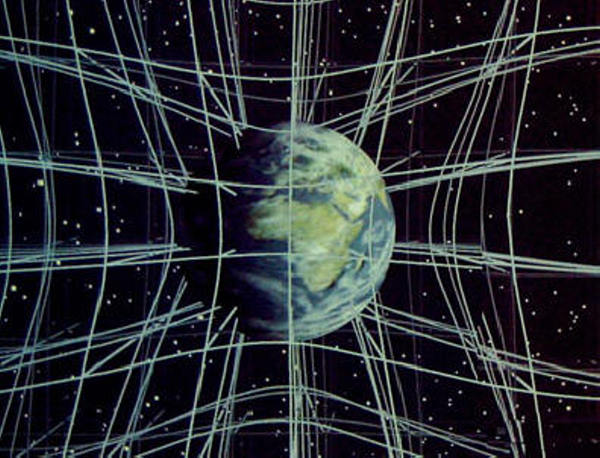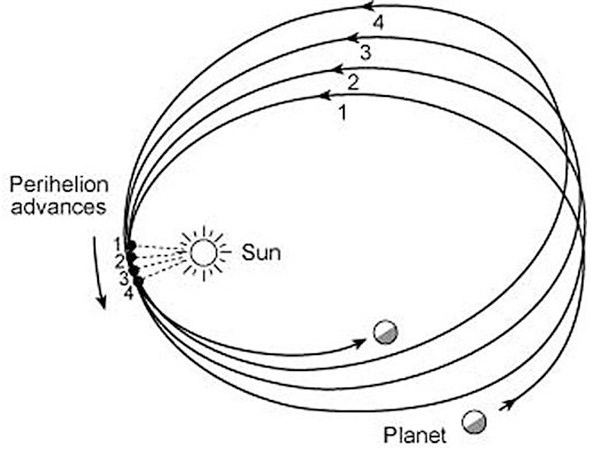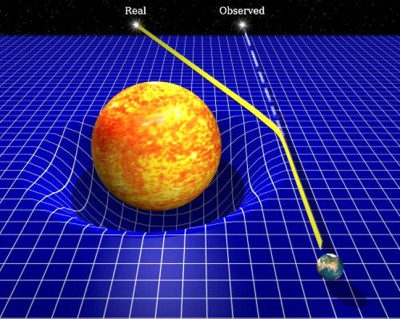
When you hear about “space-time,” it’s just a way to say that space is related to time. And the curvature of space-time, as Albert Einstein predicted, is the way space and time alike literally bend around a mass such as the Earth or the sun.
That’s what’s diagramed above. This is a three-dimensional concept diagram of the way space sort of “clings” to an object. Notice the way it sort of tightens up when you get close to Earth? And because time is part of this whole equation…time sort of tightens up, too.
I assume that explains the “twin paradox,” as it’s called. That’s where the space-traveling twin returns home to Earth younger than their Earth bound twin.
Why? Seems to me it’s because time was tighter and passed faster on Earth, while it spread out and passed a bit slower for the traveler. (Don’t quote me on that, I just guessed that from this diagram.)
Einstein figured all this out. But scientists need evidence. Trusting Einstein’s genius wasn’t enough for them. How did they accept relativity as fact?
First thing’s first. We need to know how we can possibly prove something we can’t see.
In the end, it’s simple. We may not be able to see space-time, but we can see its effects—it’s literally the reason planets orbit their stars. So if we can observe planetary orbits, we can prove space-time curvature, right?
Well, not quite. Because observing planetary orbits just gets you Kepler and Newton’s equations, and we already know those work.
The trick is observing orbits of planets that pass especially close to their star. Mercury, Venus, and Earth, for example. Why? Because when you get that close to a star, Newton’s equations start to fall apart a little.
Newton’s laws of motion and gravity work well up to a point. But close to a star, we’re dealing with extreme forces of gravity that those equations just can’t handle. At least, not as well as Einstein’s equations can.
So what happens to planets when they pass close to their star?
Let’s take a look at Mercury.

What on Earth—oops, sorry, what the heck—is happening here?
Every planet has an elliptical orbit, as demonstrated by Kepler. And having an elliptical orbit means that a planet will be closer to the sun on one side of its orbit than the other, as shown here.
When the planet is closer, it’s called perihelion. And at perihelion, Mercury slips that much closer to the sun. Newton’s equations start shooting out errors where Einstein’s don’t.
What errors?
Notice above that every time Mercury swings around the sun, its orbit changes a little. The shape doesn’t change, but aphelion—the point when it’s the farthest from the sun—occurs in a different place every year.
(By that I mean Mercury years, by the way. One full Mercury orbit.)
Over time, perihelion moves, too. This is called the advance of perihelion of Mercury’s orbit. It’s not a huge distance, but over time, it’s definitely noticeable. It’s like they say—pennies add up.
In the same way, the errors in Newton’s equations weren’t that noticeable at first. But a century after Mercury’s advance of perihelion was first measured, those errors had accumulated, like a watch losing a second every year.
Only Einstein’s equations could calculate where Mercury’s perihelion really had moved to. And that was strong evidence in their favor.
Then, of course, there’s the bending of light…
Of what?
Well…we’ll cover this in depth later, very soon in fact, but yes, light does bend. It’s the reason you sometimes see a rainbow. It’s also why refracting telescopes work. And it’s why lunar eclipses happen. And it’s why…
Okay, we can get into that later. For now, just know that light is capable of bending. Except in the vacuum of space, it travels in a straight line.
Most of the time.

Just as space-time changes the direction of planets and makes them travel in orbits instead of straight lines, it changes the direction of light. Yes, that’s right. Gravity can change the direction of light.
Normally, when we see the stars in the sky, we see them a straight-line path directly in front of where they really are. So their apparent position among the other stars is exactly where it should be.
All that changes if we observe those same stars when they’re near the sun in the sky.
But…wait. How can we possibly do that, when the sun is so bright it drowns out all the other stars?
Well…lucky for us Earthlings, our moon appears the same size as the sun’s disk in the sky, and every once in a while, it actually covers up the sun—enough to block out the sun’s light entirely in a certain region of the Earth and get night during the day.
That’s a total solar eclipse, by the way.

When a total solar eclipse happens—surprise! —we can actually see the sun and the stars that appear near it.
And if we take a picture then and compare it to one taken of those same exact stars from a few months ago, when they weren’t near the sun in the sky, we can compare their positions at both times.
It turns out, stars that are close to the sun in the sky actually appear to move away from the sun, compared to their positions when we photographed them at night.
That’s explained in the diagram up above. As a star’s light grazes the sun’s surface, gravity bends it before it reaches Earth. The star appears to be a straight-line’s path behind it in the sky, which isn’t true, because the light bent.
This experiment has been tried time and time again, and when the stars’ distances from their real positions is measured, it’s always well within Einstein’s predictions. That’s pretty good confirmation for his space-time theory.
Of course, science is always in flux. We can’t definitively prove most things because we have to be open to knew ideas. In fact, even Einstein’s equations fail to explain what happens extremely close to a black hole.
Astronomy has a long history of adapting to new ideas. Over the course of thousands of years, it developed from a philosophy into an observational science. Galileo was one of the first to practice experimental science and figure out the laws of physics.
Even then, Newton found ways to improve upon his laws. And Einstein put both of their scientific careers to shame.
Someday soon, another genius may arise who even puts Einstein in his place. We’ll find a way to explain the physics of black holes, where even relativity falls short. But even then, how do we know there isn’t something else out there that our knowledge of physics can’t explain?
I hope that one day, we’ll figure out it all. We’re capable, and we’re daring. The question is if we can ever know for certain that we’ve reached the end of the road.
Personally, I hope that if we do, it takes us a darn long time.
Excellent post, but I think the comment on the twin paradox is wrong. The closer you are to a gravitational source, the slower time moves. So the twin on earth would age more slowly that the twin is space. But, I’ve always heard the twin paradox in terms of the twin travels near light speed and returns in 30 earth years, while in his own time, only a year passed. So this twin paradox is a different part of Einstein’s theory ,but I don’t know if it’s part of the special or general theory. Special equates acceleration to gravity, right? but general equates falling to time. ?? Not sure. so I better shut up.
LikeLiked by 1 person
This is why I didn’t go into detail. It was under the special relativity section of my textbook but was not elaborated on. Also, I didn’t specify the speeds we’re talking about here. I would say that it wasn’t wrong, just vague—and purposely so. Special relativity says that velocity is relative. General relativity equates acceleration to time. And the twin paradox is part of something, but is an example of time being inconstant and so I used it in my general relativity post (but made it clear it wasn’t part of that theory).
LikeLike